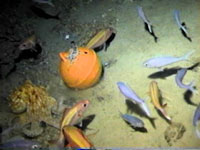HURL
2002
Driving
the Sub
(9/13/02)
Posted
by Rachel Shackelford
 We've
been out here for a few days now - starting to get the hang
of the routine. Breakfast starts at 7:15. The sub goes in
the water between 8:00 and 8:30. We have three sets of observers
(a.k.a. fish counters), so after today each of them will
have had a chance to test their skills at calling out the
names of the fish that swim by the sub's portholes.
We've
been out here for a few days now - starting to get the hang
of the routine. Breakfast starts at 7:15. The sub goes in
the water between 8:00 and 8:30. We have three sets of observers
(a.k.a. fish counters), so after today each of them will
have had a chance to test their skills at calling out the
names of the fish that swim by the sub's portholes.
Once
the sub reaches the bottom, the routine is that they will
do three 30-minute transects, each at different depths,
and two 30 minute bait stations. During each transect, the
sub moves in a straight line while the observers count all
the fish they see. There are three 6-inch portholes (a.k.a.
windows) in the sub; the pilot uses the middle one to see
where he is going and the two observers use the ones on
either side of him. For half an hour, each observer must
press their forehead up against the porthole and call out
how many of each type of fish and invertebrates that they
see. One person might say, "4 onaga, 2 ehu, one seastar
with yellow tips" then as soon as he pauses the other
observer would jump in and say, "3 kahala, 5 maunaloae,
2 Grammatonodus laysanus." Although the observers memorize
the scientific names of all the fish and inverts that they
are likely to see, it can be hard to spit out those long
convoluted names all in a row. So sometimes they use the
Hawaiian or common name for the fish and sometimes they
call it by either its genus or species name. The main thing
is that they must call it by a unique name that should be
obvious to the person that will have to log the videotape.
This audio record comprises the primary data that comes
out of these fish transects.
 In
between the transects, they find a good rocky place that
is not too steep where the sub pilot breaks open a bag of
bait, backs the sub off a bit, and turns off the lights.
Not very much light makes it down to 200 or 300 meters (over
600 and 900 feet, respectively), and the little bit of light
that does make it down there is blue. With the lights turned
off everything that previously looked red, orange, or yellow
appears to be black. A low-light CCD black & white camera
mounted on the sub captures the natural behavior of the
fish under natural light conditions.
In
between the transects, they find a good rocky place that
is not too steep where the sub pilot breaks open a bag of
bait, backs the sub off a bit, and turns off the lights.
Not very much light makes it down to 200 or 300 meters (over
600 and 900 feet, respectively), and the little bit of light
that does make it down there is blue. With the lights turned
off everything that previously looked red, orange, or yellow
appears to be black. A low-light CCD black & white camera
mounted on the sub captures the natural behavior of the
fish under natural light conditions.
The
sub pilot aims to leave the bottom by 4:00 pm and it is
often hard for the observers to get all their work done
in that time. They have done pretty well so far, though.